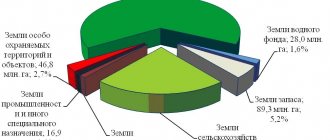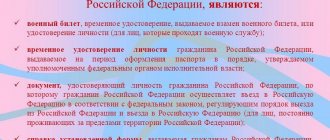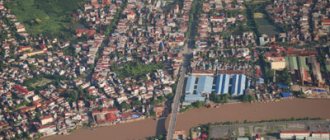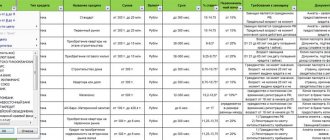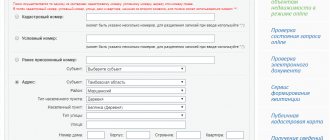Concept and characteristics of the land fund of Russia
The entire Russian territory, the totality of lands located within the state borders of the Russian Federation and divided into categories according to their intended purpose, including those covered by forests and located under water, constitute its property and are included in the concept of the land fund.
With an extensive land fund of 1,709.8 million hectares, Russia is the world leader in terms of territory.
The geographical location of the country and its natural and climatic conditions explain the uneven distribution of resources used in the national economy. For example, only 8.9% of the land (190.3 million hectares) is plowed, and 62% (1046.3 million hectares) is covered with forests.
However, the land fund of the Russian Federation is all the land resources located within its borders and constituting the territorial basis of the state.
Historical retreat
Initially, the socio-economic and political structure of the Russian lands was fragmented. For this, different prerequisites have developed in society under the influence of reasons:
- social;
- economic;
- external and internal environment.
The security of the feudal control system required the merging of vast territorial spaces, in which different structures with their own hierarchy were formed.
At the highest level were the princes, endowed with supreme power; they had property and the right to dispose of it. The boyars had extensive estates, the estate was part of advisory councils under the sovereigns, they could choose which of the princes to obey.
They, in turn, brought loyal comrades closer to them, who later received the status of nobles, rewarding them with estates for temporary use for their service. The socio-economic and political structure of the Russian lands governed society. Allotments served as a sign of privileges, rewards and a bargaining chip. The princely mercy could either transfer the land to the disposal or take it away for any offense.
Composition of the land fund of the Russian Federation
Russia's land resources represent a single natural object, despite the fact that at different times its individual parts may be owned and exploited by different legal entities.
The Russian land fund includes resources that:
- perform recreational, nature reserve, and health functions;
- used as a means of production, a spatial economic basis.
According to the provisions, all lands included in the fund are divided into categories in accordance with their intended purpose. The largest of them is agricultural land. They, in turn, are also divided into groups in accordance with the main and auxiliary tasks assigned to them.
The same applies to other categories. For example, the structure of the city’s land fund includes land:
- public areas: squares,
- streets,
- squares,
- boulevards;
The structure of the fund as a whole sometimes changes due to economic, social, environmental and political factors. Such transformations may also affect certain categories of the land fund. It happens:
- when transferring land from one category to another;
- in case of privatization of the site;
- in connection with the development of business activities in the field of use of land resources;
- for other significant reasons.
The composition of such resources belonging to the subjects of the federation or other administrative-territorial units, for example, the structure of the land fund of the region, is subject to constant analysis. All changes in the share ratio are recorded.
How it was? The formation of land reform since the collapse of the USSR
After the collapse of the Soviet Union, the country faced huge changes. One of the most pressing issues of those times was the issue of redistribution of land areas. The transformations began successfully: in the first year they carried out a land inventory
, allocated 950 thousand plots for gardening and vegetable gardening, created and allocated land to more than 100 thousand peasant (farm) farms.
Of course, the transition to the new system took more than one year, and this situation caused quite a few contradictions in society and political ranks. Viktor Khlystun, academician, Minister of Agriculture of the RSFSR, author of the 1990 reform, said: “Radical reformers then insisted on including land in the general privatization fund and allocating it to all citizens using vouchers. We were categorically against it: only rural residents had the right to land.”
The main transformation was that after the reform of 1990, private ownership of land appeared in the country
.
Georgy Yaroshevich, Doctor of Agricultural Sciences, director of the Research Institute of Agriculture in Pskov, commented on the outcome of all this as follows: “All agricultural institutes and academies located near cities suffered. In 2009-2010, fertile land for construction began to be taken away from us
dachas, new buildings and cottages.”
“The breakdown of land management that began in the late 1990s has led to gross mismanagement.”
– Viktor Khlystun complained.
Fund management system
A separate sphere of public administration is the management of the land fund of the Russian Federation. The area of his authority is land in the broad sense of the word.
The subject of legal regulation is the system of legal relations in the field of protection and rational use of land resources as an object of economic management.
The management bodies of the land fund of the Russian Federation are united into an integral system.
Depending on the powers received by these structures, a division into bodies of general and special competence is provided.
The former carry out general management and regulate all land-legal relations existing in the state. The latter are vested with a limited range of powers in the management of the land fund and perform public administration functions that relate to a specific area of coordination: maintaining the state land cadastre, monitoring, land management and others.
The first group includes government bodies of the Russian Federation:
- President and heads of constituent entities;
- Federal Assembly and legislative assemblies of constituent entities;
- Government and constituent authorities;
- local government bodies.
Bodies of special competence included in the second group are determined by the Decree of the President of the Russian Federation and include ministries, federal services and agencies.
State management of the land fund in 2021 is carried out at several levels:
- federal (territory of the entire state);
- subjects of the Russian Federation: lands within the republic, territory, region, autonomous regions and districts, cities of federal significance;
- municipalities: land resources of districts, cities, other settlements.
Who owns the lands of the Russian Federation?
Russia naturally occupies the world leadership in terms of land resources. “Today no one in the country knows what the size of Russia’s main national wealth is and how much it is worth,” notes Viktor Khlystun. Indeed, the cost of land plots across the country varies from several thousand to several million rubles per one hundred square meters of land!
The difference in cost is colossal, and it is explained, first of all, by climatic factors.
For example, the cost of a plot of land in Sochi or Crimea significantly exceeds the cost of a plot of the same area located in the outback of Tatarstan. There are many examples that can be given. It should be understood that in resort towns, as well as in cities with a population of over a million, the cost of land will always be inflated.
Unfortunately, despite the land wealth of our country, the population cannot fully enjoy this wealth
. The land reform at one time changed the fate of thousands of citizens, and many still do not have the opportunity to purchase a plot of land for themselves, because everything around them was bought out later in the 1990s.
“One of the main reasons for the current situation is the lack of demarcation between state lands. It is not clear which land is federal, which is municipal, and which belongs to the subject of the Federation, that is, regional authorities,” says Natalya Shagaida, Doctor of Economic Sciences, Director of the Center for Agricultural Policy at the Institute of Applied Economic Research of the Russian Presidential Academy of National Economy and Public Administration.
Currently, a huge amount of unclaimed land is owned by municipalities.
These are the shares of those rural residents or their heirs who did not allocate land into individual plots, did not manage to sell it, or did not lease it at the time.
According to the Ministry of Agriculture of the Russian Federation, there are more than 390 million hectares of agricultural land in Russia. Of these, a little more than half, namely 196 million hectares, are land (arable land and pastures). Huge areas, unfortunately, are not in demand.
Pyotr Stolypin also said that “in the matter of land management, hard work and long-term “dirty” work are needed.” Today, huge areas of land are empty due to the burden imposed on them
. Wealthy businessmen buy hectares of land as investments, and then pledge them to banks as collateral to obtain new loans and generate new profits. However, not only farmers, but also the economies of many regions suffer from such actions.
In general, official responsibility for agricultural lands, their control and monitoring rests with the Ministry of Agriculture of the Russian Federation. But a special Housing Construction Fund monitors the buildings. In theory, everything is simple, but in practice, in order to obtain this or that permit (or certificate), you need to bypass many authorities
. “And we don’t even have a single specific body for land management,” Natalya Shagaida comments with regret.
Land categorization and its principles
As an economic object, the land fund is characterized by certain indicators, such as the distribution of land according to:
- types and forms of ownership;
- intended purpose (categories);
- land uses, land tenures and land plots;
- lands.
The distribution of the land fund by land category is the most important form of organizing their use. It is carried out on the basis of establishing the dominant factors of productive capabilities and zoning of the territory. Each site is assigned to a certain category, which establishes in relation to it the legal regime of economic use, protection, its goals and objectives.
The Land Code of the Russian Federation defines 7 categories, which include land:
- settlements (settlements);
- agricultural purposes;
- water fund;
- energy, industry, broadcasting, transport, land for defense, space security activities and other special purposes;
- stock;
- specially protected objects and territories;
- forest fund.
Find out in more detail what features land categories have in the Russian Federation.
Where are the settlements located?
Settlements are also located on the ground. For them there are borders in the area of cities or towns according to territorial zones:
- residential;
- production;
- social and business;
- recreational;
- engineering and transport;
- with a special purpose.
Each zone is subject to:
- own regulations;
- legal regime;
- targeted use of land plots.
Local government may prohibit the use of a site if the regulations are violated or the parameters do not correspond.
Resource usage
The principles of using the land fund are based on the assignment of a specific plot to one of the categories established by law. For example, agricultural land can only be used for educational, research and agricultural production purposes.
Individual citizens may use such lands for the following purposes:
- running a personal subsidiary or farm (peasant) farm;
- livestock farming;
- horticulture;
- haymaking;
- grazing;
- gardening.
The misuse of certain categories of land is legally prohibited.
What areas are allocated for industrial production?
Enterprises are located on lands remote from cities if they are intended for hazardous production. The factory can be located within the boundaries of the settlement, provided that it does not harm the townspeople or the farms of the villagers.
Industrial sectors include energy, transport, and communications. In any case, designated areas have security, sanitary zones with special uses, conditions and requirements for them. They create restrictions on land use rights for any ownership status.
